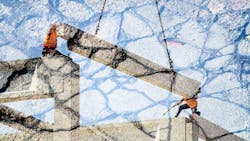A New Way to Discover a Reaction that Causes Cracks in Concrete
Bridges, dams, nuclear plants and other concrete structures are built to stand for decades, but they are not indestructible.
One phenomenon that shortens the life of concrete buildings and structures is the alkali-silica reaction (ASR). It is the reaction between alkali ions found in cement and silica, the two main components of concrete, which creates a gel that absorbs water and expands, causing internal pressures to build up within the concrete.
Over time, this pressure can crack concrete structures and degrade them. There is currently no cure for ASR, and it is both destructive and time-consuming to identify it in existing structures.
To help identify the extent of ASR, researchers at the Argonne National Laboratory have discovered a harmless way to detect it that could reduce the level of expensive testing being done. Their new method relies on electrochemical impedance spectroscopy (EIS), which measures electrical conductivity.
Until now, only way engineers could spot ASR was by taking several core samples and analyzing them under a microscope.
“This detection method is costly, time-consuming and destructive, which is not ideal,” says Argonne scientist Alexander Heifetz.
Heifetz and his research team discovered that EIS can nondestructively detect ASR.
Electricity gets conducted in concrete through networks of pores which form during curing and contain ionic fluids. The gel that forms during ASR spreads to fill the gaps in these networks.
Researchers theorized that ASR affects the ionic fluids within the pores, as well as the connectivity of the pore networks themselves. This, in turn, could change the concrete’s electric conduction, which the researchers could measure using EIS.
Engineers have used EIS to indirectly measure mechanical properties of concrete, such as strength during curing. But the Argonne team are the first to apply this method to detect ASR.
To test its reliability, the team induced accelerated ASR in concrete samples. The team than then measured EIS on the samples and calculated the electrical resistance of concrete from the data.
The team found that ASR changes the concrete’s electrical resistance, creating a signature that scientists could use to distinguish and locate ASR.
“We basically found a way to characterize a material’s property based on its current conduction, and in the end, we found there is correlation between conduction and the presence and progression of ASR,” says Heifetz.
EIS is nondestructive, so using it to monitor ASR could reduce the amount of curing needed to diagnose and monitor high-value concrete structures.
“We have the potential to develop this into a technique for use on structures,” Heifetz said. “We’re now working with industry to see if this approach will work on a greater range of geological samples than those used in our study, to hopefully advance its application.”
